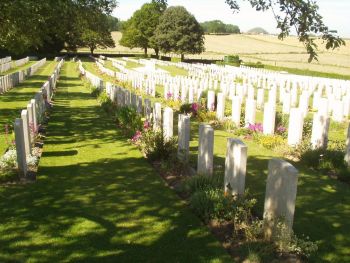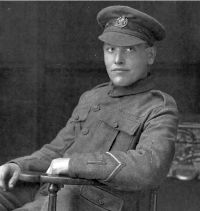|
|
| Home Topics Memorials Miscellany Transcripts References Family History Glossary Latest Beeston Blog About us | Site Search |
|
Although his Army Service Record has not survived, it appears likely that both Albert Ernest and his brother Reginald Horace were already active with the Territorial Force in the 7th (Robin Hood) Battalion,
Sherwood Foresters (Notts & Derby Regiment) On 25 February 1915 For Private Barker, for his brother and for many of their colleagues, these first few months had been a terrible introduction to trench warfare - but the worst was to follow in the months that came. In the last days of June 1916, the Battalion was in position, as part of 46th (North Midland) Division, for what was to be the great Somme offensive against the German held Leipzig Salient. During this time, the German lines were pounded by artillery fire which was so intense at times that it was thought that the enemy defences would be so destroyed as to make the intended major attack possible. Bad weather had delayed the attack intended for 28th June and the Battalion was held in the Foncguevillers area, at the northern end of the line, opposite Gommecourt, awaiting orders to move forward for the attack. At 7.27am on 1st July, smoke was discharged and the battalion attacked in five waves at 7.30am with 5th Battalion Sherwood Foresters on its right. In the confusion of heavy smoke and unexpectedly strong German counter-attacks, only a small number of men were able to reach the German line, having found gaps in the wire. Overall, the men faced very heavy resistance, heavy machine gun fire and bombing attacks which made significant advances impossible and there were very heavy casualties during the first hour. German artillery fire bombarded the trenches all morning resulting in many more casualties. By the time the battalion was withdrawn in the late evening, casualties totaled 19 officers and 424 other ranks. Of these, about half were known to have been killed or were missing. The two brothers were very fortunate to have survived that terrible day. Much of the remainder of the year was spend in replenishing numbers and re-training but also with inevitable periods in the trenches - in increasingly difficult conditions with cold, rain, snow and flooded trenches making everyday life a miserable experience. During the first part of 1917 the battalion took part in a number of operations against the enemy9, notably at Biez Wood near Gommecourt and near Loos. In June, on the night of 29/30th, it again advanced against the enemy at Lievin, near Lens, north of Arras, with some success but with about 40 casualties. Sadly, Albert's brother - by then Sergeant Barker - was one of those killed. Towards the end of September 1917, the battalion moved to Mazingarbe, again near Lens in the Pas-de-Calais, where they took over the line at Hill 70, which had been captured by the Canadians in August. After the heavy fighting that had taken place, the trenches, particularly the one remaining communication trench, that the battalion took over, were in an atrocious condition, very wide, battered and full of mud. The weather was bad, the trenches filled with water and the men worked night and day to try to keep them cleared. There were frequent enemy raids, all of which were beaten off, and trench mortar fire was particularly active but, despite all these difficulties, morale remained high. On the night of 4/5th October the battalion was to be relieved by the 8th Sherwood Foresters, from its position in the Hill 70 area. These changeovers are always dangerous times and, on this occasion, the battalion faced a heavy barrage of trench mortars and artillery fire and there were attempts by the enemy to attack the trenches which were rebuffed. The relief was eventually completed though with one other rank killed, 12 wounded, three or four seriously. Private Barker was one of those seriously wounded9. Private Barker would have been first taken to an aid post close behind the line and then by field ambulance to a Casualty Clearing Centre. Once identified as seriously wounded and needing advanced treatment, he would have been evacuated to a Base Hospital, usually by rail on an ambulance train. A letter received by his mother from an officer who had known Albert and was at the same hospital, paid tribute to his character and brave spirit in his final days10. Sadly, he died on 16 October and was buried in Lapugnoy Military Cemetery. Lapugnoy is a village 6 kilometres west of Bethune. The military cemetery can be found on the left hand side, about 500 metres, along a track off the D70, on the outskirts of the village, in the direction of Marles-les-Mines. The first burials were made there in September 1915, but it was most heavily used during the Battle of Arras, which began in April 1917. The dead were brought to the cemetery from casualty clearing stations, chiefly the 18th and the 23rd at Lapugnoy and Lozinghem, but between May and August 1918 the cemetery was used by fighting units. Lapugnoy Military Cemetery contains 1,324 Commonwealth burials of the First World War, three being unidentified, and eleven from the Second World War11. He was posthumously awarded the British Medal, the Victory Medal and the 1915 Star12. Albert Ernest's army financial effects of £9 16s 11d were paid to his father on 4 February 1918 (and a further 18s was paid on the 28th of the following month). His father received his son's War Gratuity of £14 10s on 26 December 191913. John Thomas & Annie Barker, having lost two of their three sons in the war, continued to live at 22 Mona Street up the John's death in 193314. Annie died in 1941, from 193 Leigh Road, Eastleigh, Hampshire, probably having gone, as a widow, to live with a relative15. They are buried together in Beeston Cemetery, where a memorial stone survives.Footnotes 1The photograph of Lapugnoy Military Cemetery, France is from the Commonwealth War Graves Commission website. (http://www.cwgc.org) 2His birth was registered, in Loughborough Registration District in Q1 1897 (Ref 7a 126) 31901 Census, Piece 3184 Folio 132. 41911 Census, Piece 19109 RD405 SD1 ED11 Sched 196. Albert Ernest's then surviving siblings were Reginald Horace (b. c1896) and Arthur Bryan (b. c1909). A further sibling had died in infancy. 5This Beeston address is given on both sons' memorial pages on the Commonwealth War Graves Commission website. As their youngest son was born in Beeston in 1908, it seems probable that they had spent some time there between living in Nottingham in 1901 and Loughborough in 1911. 6Their approximate enlistment date has been calculated based on the amount of their War Gratuity. The brothers' service numbers, in the same regiment, are only 67 apart. An earlier Notts & Derbys Service Number of 1776 appears on his medal card and in the medal rolls 7Details of 1st/7th Battalion's formation and deployment in 1914-1917 are based on "The Robin Hoods", 1/7th, 2/7th & 3/7th Battns., Sherwood Foresters, 1914-1918" by Horace Smith-Dorrien, 1921. 8The date is shown on his medal card, apparently erroneously, as 25 February 1917. However, his award of the 1915 Star and the 1915 date in the respective Medal Roll confirm the earlier date. It should be noted that he was aged only 18 - underage for overseas duty but one among many who had perhaps overstated their age when joining. 9Details of the battalion's operations in October 1917 are from its War Diary, available on ancestry.com. A note in the diary on 16th October reads : '265187 Private Barker A.E. wounded night of 4/5th. Died in hospital of wounds 16/10/17'. 10The full text of the letter is included on Albert Ernest's memorial page on the Nottinghamshire County Council Roll of Honour site (www.nottinghamshire.gov.uk/rollofhonour/People/Details/4913). 11The description of Lapugnoy Military Cemetery, France is based on that on the Commonwealth War Graves Commission website. (http://www.cwgc.org) 12Albert Ernest's medal awards are recorded on his Medal Card and on the Medal Rolls, available on ancestry.com. Both brothers' medals, Death Plaques and scrolls are or have been offered for sale on the Medals of England site (www.medalsofengland.com/medals.php?id=121&medalid=616) 13Army Registers of Soldiers' Effects, 1901-1929, available on ancestry.com. 14He died on 10 June 1933 (Probate Calendar). 15She died on 18 February 2041 (Probate Calendar). |
|
|||||||||||
|
|
|||||||||||||

 Albert Ernest Barker was born in Loughborough, Leicestershire in 18972, the second son of John Thomas and Annie (née Clowes) Barker. Around 1901 they had lived for a time at 72
Fisher Street, Nottingham where John Thomas had traded as a grocer3 but, by 1911, the family was living at 40 Leopold Street, Loughborough, where he was trading as a baker, assisted by his wife.
Albert Ernest, then 14, was working as a house painter's assistant4. By around the end of the war, the family had moved to 22 Mona Street, Beeston, Notts5.
Albert Ernest Barker was born in Loughborough, Leicestershire in 18972, the second son of John Thomas and Annie (née Clowes) Barker. Around 1901 they had lived for a time at 72
Fisher Street, Nottingham where John Thomas had traded as a grocer3 but, by 1911, the family was living at 40 Leopold Street, Loughborough, where he was trading as a baker, assisted by his wife.
Albert Ernest, then 14, was working as a house painter's assistant4. By around the end of the war, the family had moved to 22 Mona Street, Beeston, Notts5.